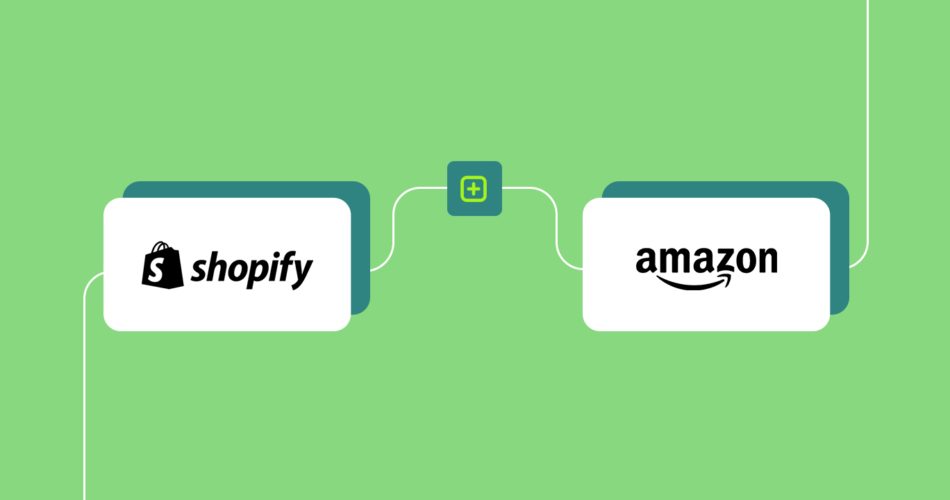Search for “Shopify Amazon integration” on Google and you’ll find dozens of articles claiming to have the answer.
Most of them suggest you create a Shopify store and add Amazon as a sales channel to that particular store through a built-in tool.
However, if you try to do that, you won’t find the “Add Amazon as sales channel” option within your Shopify store as can be seen in the screenshot below.
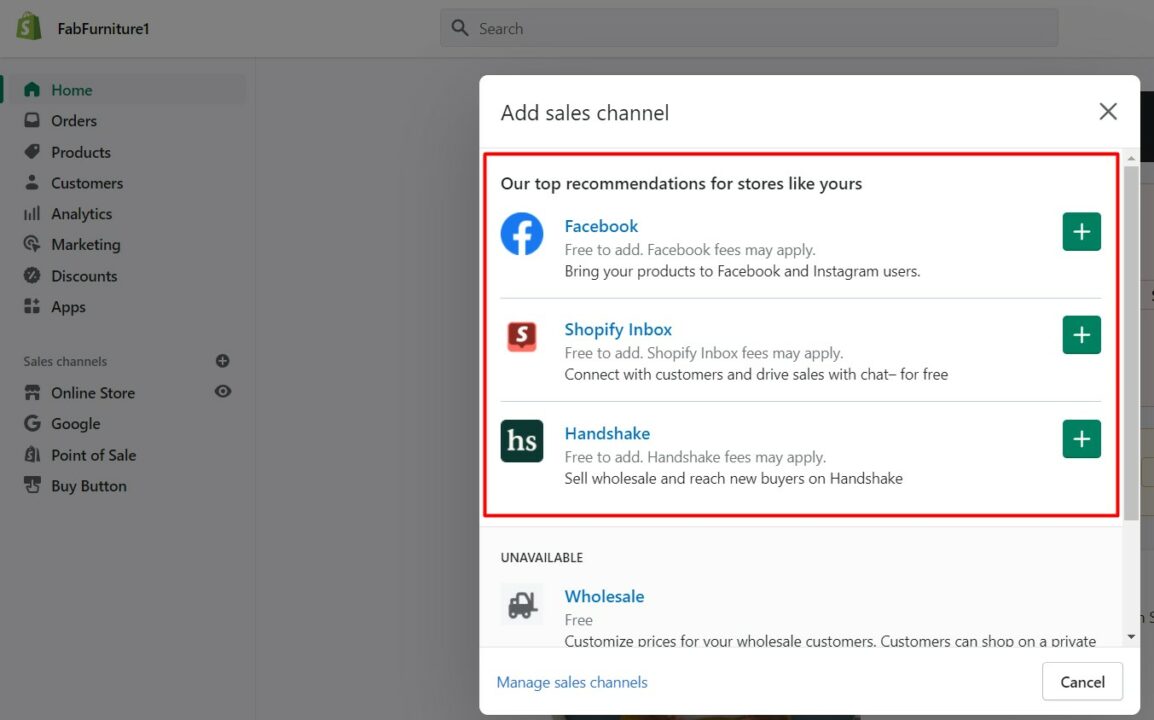
Now you might wonder, how to connect Shopify to Amazon if there isn’t any option to do so.
Well, we got you covered. Although there is no direct support from Shopify for Amazon integration, there are several third-party Shopify apps that can help you with the integration.
We’ll take you through the integration process in the latter part of this post.
First, you should understand how critical it is for retailers to have a presence on both Amazon and Shopify.
And if you need a solution to market your products on either platform, you can start leveraging Omnisend for free.
The importance of Shopify Amazon integration
When it comes to Shopify and Amazon, there’s no “either” and “or”. Both the platforms are unique and different from one another in terms of peer competition, branding, SKU management, and more.
Shopify provides you with a platform and tools to build your own online retail store whereas Amazon is a marketplace where you can sell alongside other retailers.
Hence, it’s crucial for an online retail business to leverage the omnichannel retail approach by connecting Shopify to Amazon.
Let’s understand why these platforms, individually, are essential for every online retailer’s marketing strategy.
Why Shopify?
Shopify allows you to create and run an online retail store for which you are free to choose your domain and website design. The Shopify platform offers tons of ready-made website templates that you can apply to your store to get it up and running.
It’s specialized for online retail business and this is why a lot of retailers prefer having an online store on Shopify.
Ever since its inception, Shopify has been growing exponentially. In fact, Shopify had the highest market share in the United States last year at 29%.
Following are the reasons why Shopify is a preferable ecommerce platform for retailers:
Provides a website – Having an ecommerce website is a boon for every retailer. The website gives you control over customer journeys, user experience, sales funnel, and marketing strategy.
Supports dropshipping – Shopify makes dropshipping a breeze by integrating seamlessly with apps like Oberlo, Modalyst, and Spocket.
Best-in-class hosting – Even the basic Shopify subscription includes reliable and robust hosting which is all-time available (99.9% uptime) and comes along with an SSL certificate.
Cost-effectiveness – With its basic plan starting from $29/month, Shopify is one of the most affordable ecommerce solutions for businesses and is highly secure and versatile.
Why Amazon?
With millions of visitors on the marketplace every day, Amazon is leading the global ecommerce market. In fact, It has reported $33.36 billion in revenue in 2021, which is approximately $12 billion higher than the previous year.
The exponential growth in the revenue of the Amazon marketplace points out that its customer base is increasing too.
With millions of users exploring different products in the Amazon marketplace, it’s a great opportunity for retailers to list their products to generate sales.
On Amazon, you don’t have to build a customer base, whereas owning your Shopify ecommerce store will require you to put the effort into acquiring website traffic to generate sales.
However, as discussed before, owning your own website is also equally important.
So, the best way to drive sales would be to get the best of both worlds. And that’s why there’s a need to connect Shopify to Amazon.
But, how do you do that?
Let’s find out.
How to connect Shopify to Amazon
Well, connecting Shopify to Amazon used to be quite straightforward until last year, when Shopify announced that it will no longer support the “Amazon as a sales channel” feature from September 27th onward.
The internet is flooded with articles suggesting to add Amazon as a sales channel via the Shopify dashboard. However, since Shopify abandoned the support for Amazon, this technique can never work.

The reason behind Shopify not supporting Amazon integration directly isn’t clear.
However, for you as a retailer, it’s crucial to know if you can perform Shopify Amazon integration even if there’s no direct option in the Shopify dashboard.
The answer is YES.
There are a handful of third-party apps in the Shopify App Store that can help you realize Shopify Amazon integration.
However, Shopify recommends the Amazon Integration Plus service to link Shopify to Amazon seller accounts.
Here’s how you can connect Shopify to Amazon via Amazon Integration Plus.
1. Set up a Shopify store
Creating a Shopify store is a breeze. Just visit the Shopify website and register for the free trial. The trial will prompt you to enter your store name (name should be unique). No need to brainstorm on the name as you can change that anytime.
After a couple of questions, you’ll land on the main Shopify dashboard. The home tab will facilitate an onboarding journey that will take you through theme customization, page creation, adding domain processes, adding products, and more.
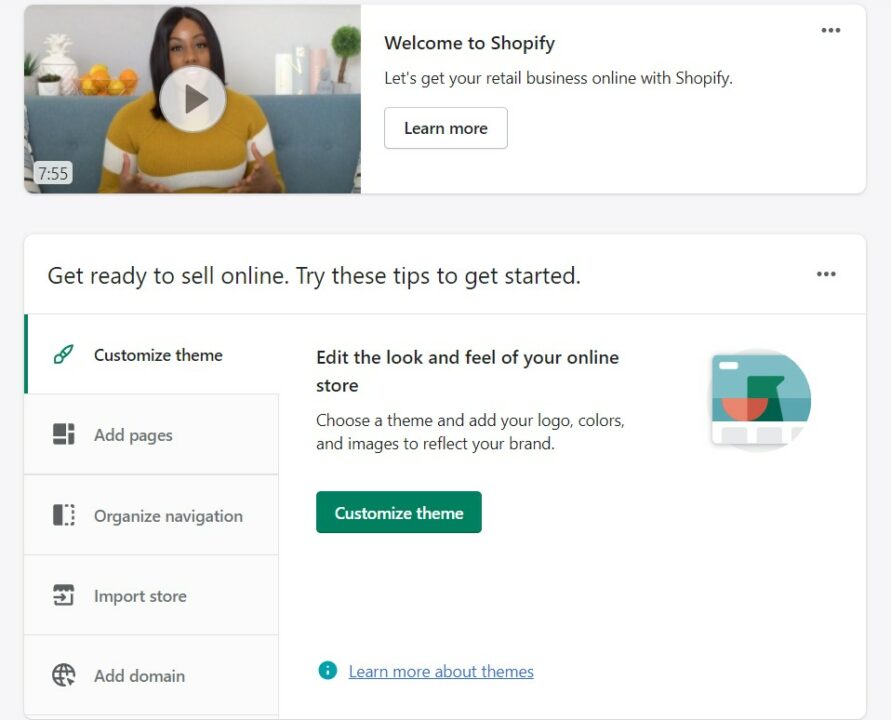
After the onboarding process, there are several processes that you’ll have to do. We can’t go in-depth into them in this article. Hence, you can refer to the following online store startup guide by Shopify.
2. Create your Amazon seller account
The next part of the Shopify Amazon integration process is to create a seller account on Amazon.
You need to visit your region’s Amazon seller central website and click on sign up.
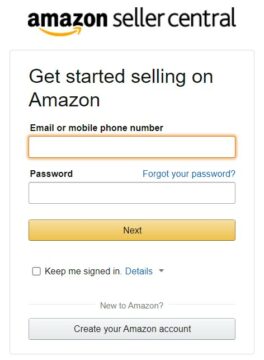
Creating an Amazon seller account is a simple process. However, make sure that you have the following details with you before getting started:
- Business name and address
- Phone number
- Credit card details
- Bank account information
- Tax ID issued by your government
3. Add Amazon Integration Plus to your Shopify store
Among all other Shopify Amazon integration apps on the Shopify store, Amazon Integration Plus is claimed to be the best and easiest alternative to the built-in Shopify Amazon integration.
Amazon Integration Plus will allow you to:
- Import products from your Shopify store to your Amazon account
- Synchronize inventory level automatically
- Adjust prices, quantities, shipping costs, etc.
- Review account summary, detailed activity reports, and real-time operations
- Connect Oberlo and other dropshipping accounts and find products on them
- Match the best corresponding offers through a matching wizard
Installing the app on Your Shopify Store is very straightforward. Just search for “Amazon Integration Plus” on Shopify App Store.
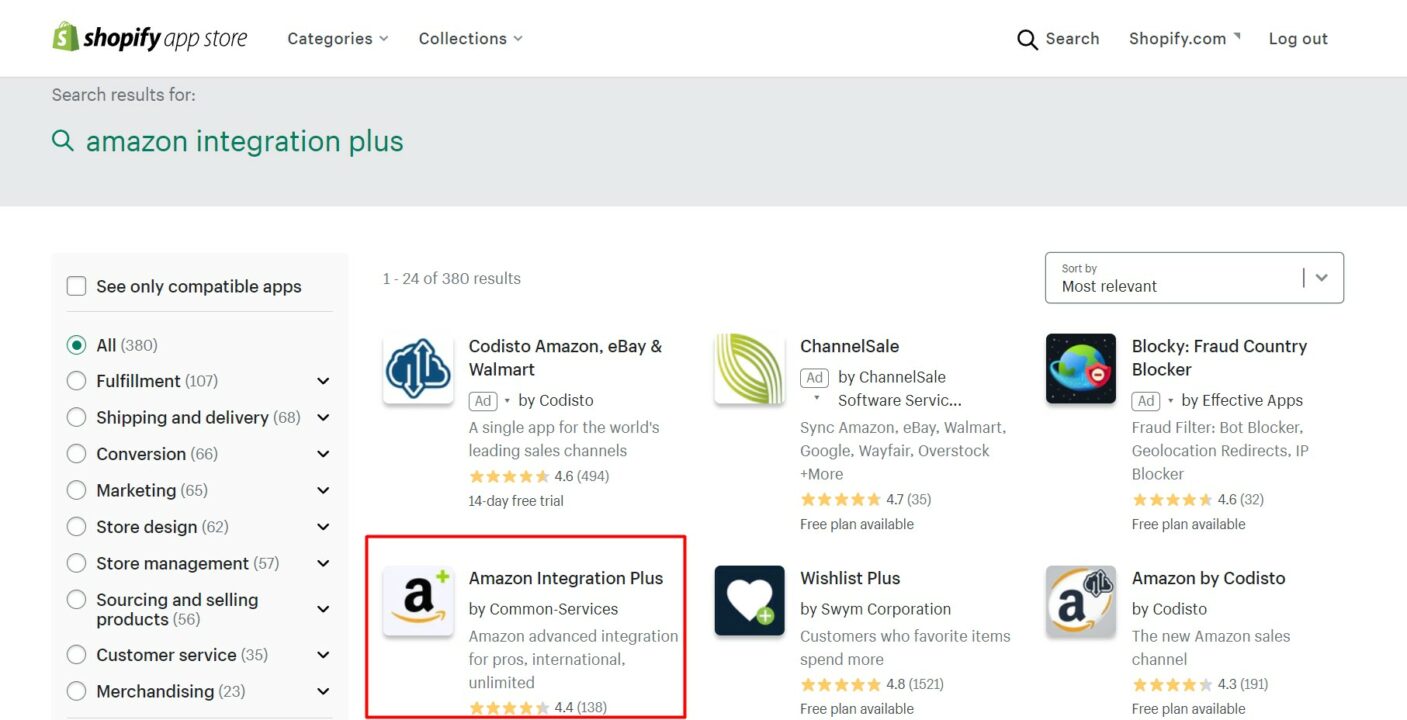
Open the app and click on the “Add App” button. You’ll be redirected to your Shopify store where the Amazon Integration Plus app will ask you for details such as your credit card details.
Don’t worry, there won’t be any deductions as the app is free for the first 30 days.
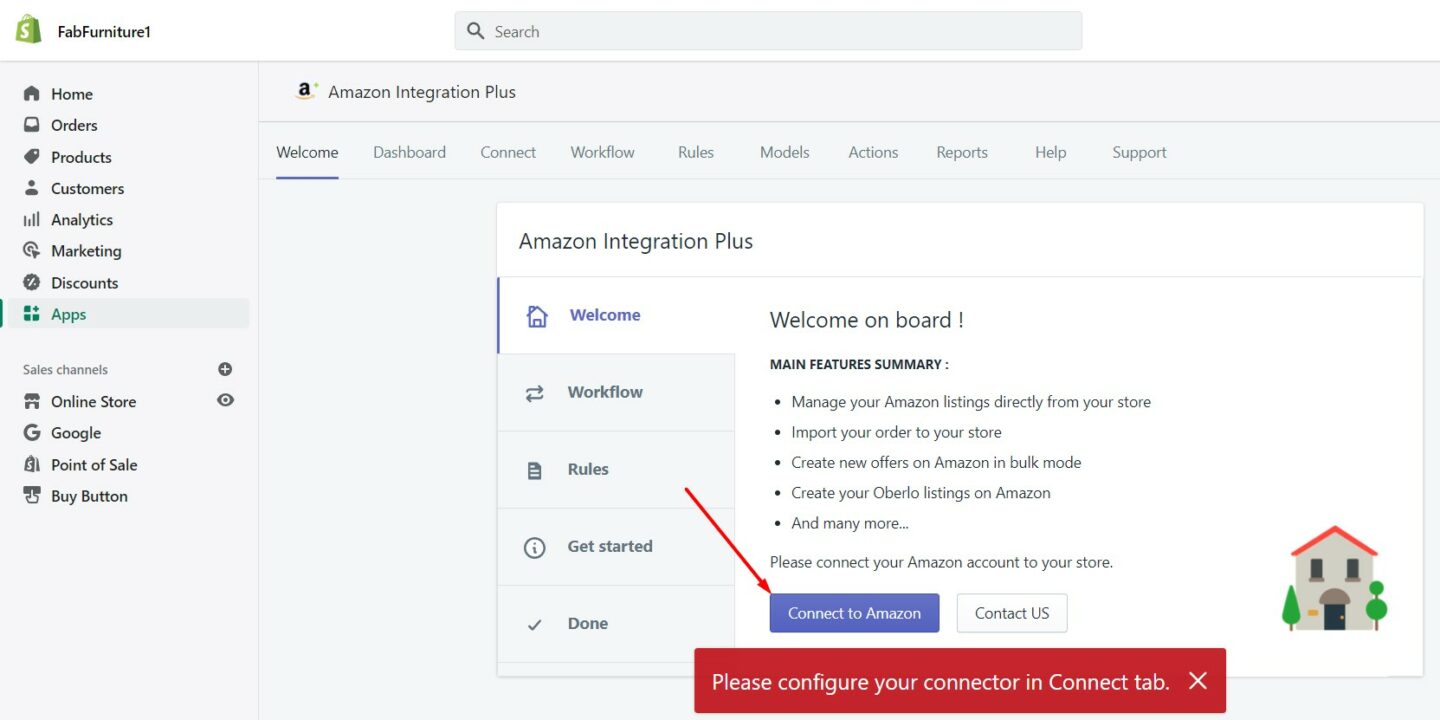
The app will require you to connect your Amazon seller account. Once you do it, your Shopify products will synchronize with your shop on Amazon.
The Amazon Integration Plus app supports multiple carriers like DHL, UPS, FedEx, USPS, etc. The app is also capable of more advanced features like multi-channel fulfillment, automatic background remover, and automatic products sheet translations.
4. Obtain your GTINs and SKUs
If you want your products to be listed on Amazon, you need to add their Global Trade Item Numbers (GTINs) and Stock Keeping Units (SKUs) along with the product description.
For the USA and Canada, the GTIN equivalent is Universal Product Codes (UPCs) whereas, for Europe, it is European Article Numbers (EANs). If you operate in any other country, you should check the requirements with Amazon.
Pro Tip: Many Amazon resellers choose cheap trade item numbers (i.e. UPCs) from devious sellers. In some cases, these UPCs can be recycled ones for which Amazon can suspect you to be a fraud and may suspend your seller account. Hence, you must be careful to purchase your GTINs only from a valid GS1 reseller.
Another important thing is that if your company is listed under the Amazon brand registry, you don’t need GTINs.
Other useful tools for Amazon Shopify integration
So far, we’ve talked about how to perform Shopify Amazon integration in terms of connecting both the stores and synchronizing Shopify products with those on Amazon.
But that’s not it.
There are several other tools that can help you make your multichannel marketing easy. Here are some tools recommended for Amazon Shopify integration.
Auto Multi-channel Fulfillment by WebBee
WebBee provides a Shopify app for multichannel fulfillment automation. The app syncs your Amazon inventory with your Shopify orders to realize faster fulfillment. You can add WebBee to your Shopify store easily, just like Amazon Integration Plus.
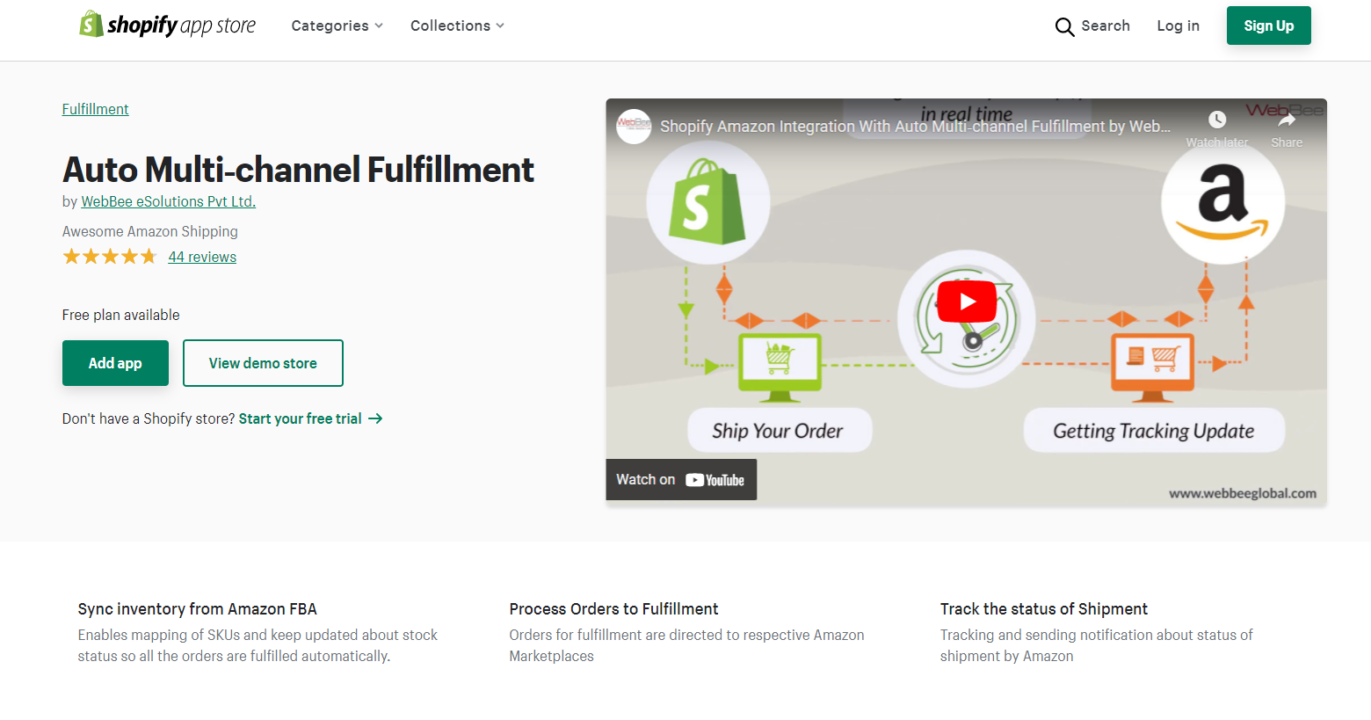
Amazon Import by ByteStand
If you already have an Amazon account and want to migrate your inventory management from Amazon to your Shopify store, ByteStand is the perfect tool for you.
ByteStand can synchronize your inventory levels along with product information like variations, descriptions, and images. You can search for “Amazon Import by ByteStand” on the Shopify App Store to find the app.
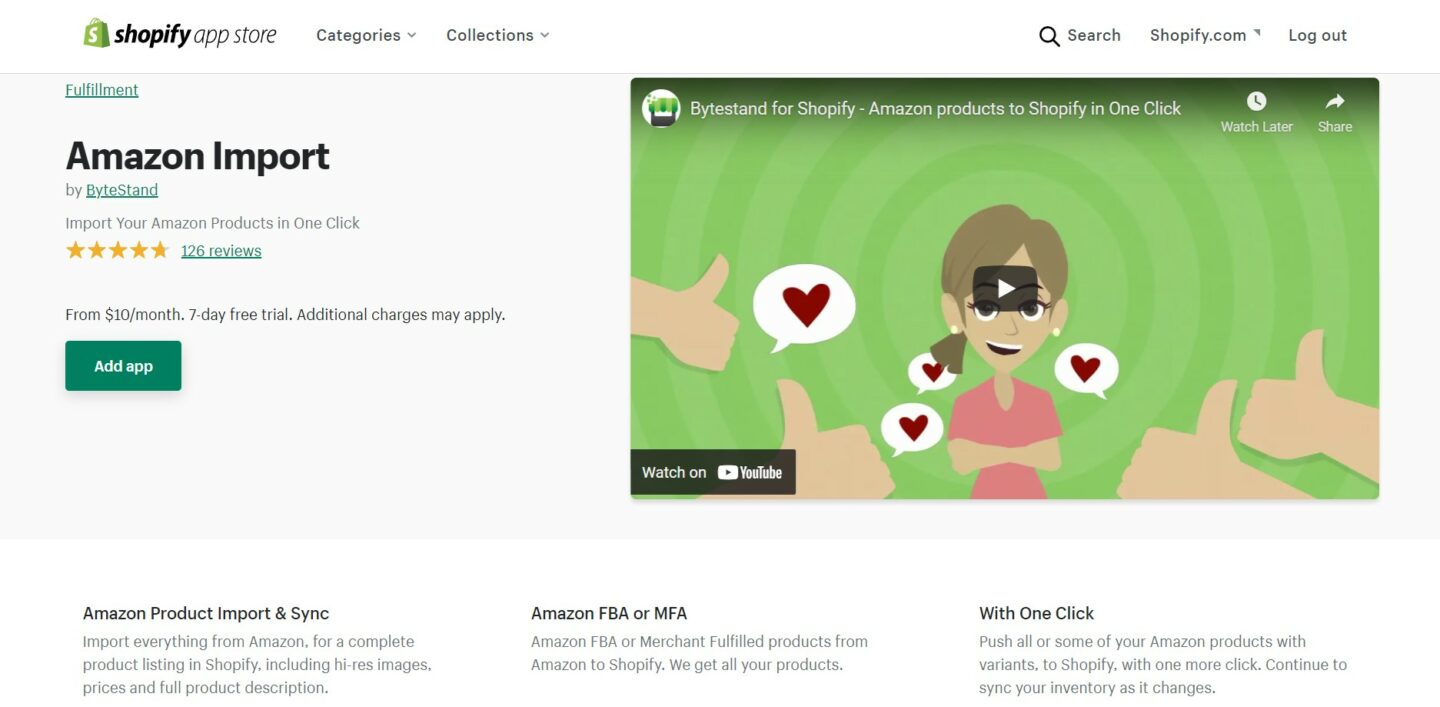
Amazon by Codisto
Amazon by Codisto is a sales and fulfillment app that can sync orders between your Amazon and Shopify store.
The app allows you to create new listings, sync your inventory and orders, and sell on any Amazon marketplace.
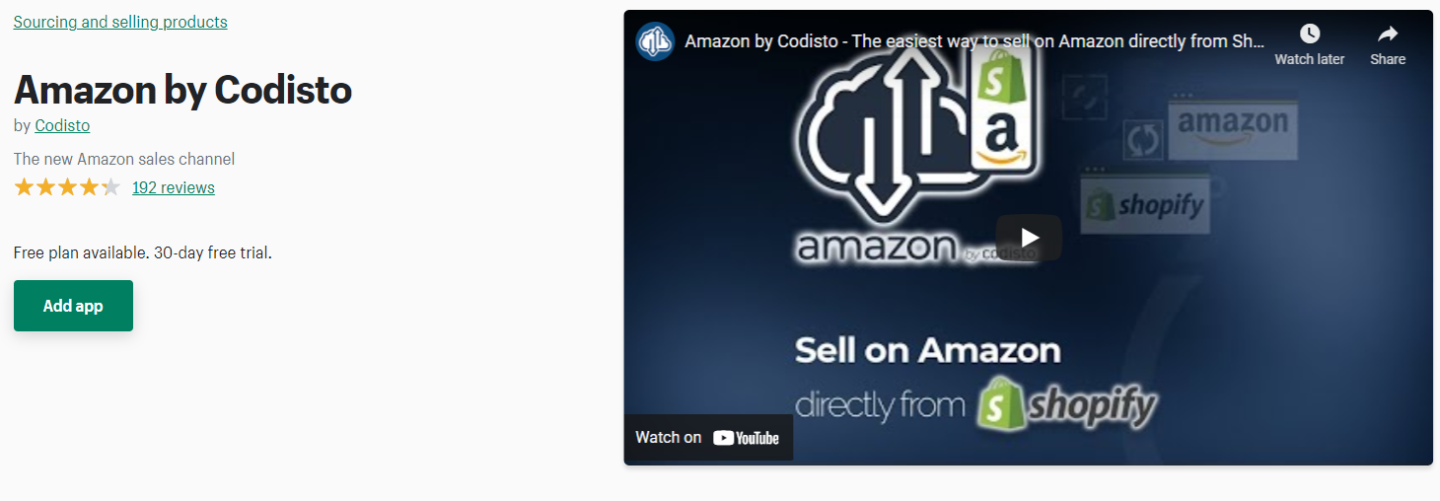
How to use Shopify with Amazon to boost online sales
Shopify Amazon integration can drive fortunes for a retail business as you can sell on Amazon through Shopify. With this multichannel strategy, you can boost your online sales, build better relationships with your customers, and make the delivery process hassle-free.
By connecting Shopify to Amazon:
- You’ll be able to sell where your customers shop.
- You can link your Shopify products to Amazon seller listings. The Amazon marketplace will automatically fetch your product details, images, variants, and SKUs from the Shopify database.
- You’ll get a holistic picture of your business as you can monitor the overall performance via the Shopify store.
However, this great power of multichannel selling means that you’d have to manage both the platforms well. Here’s a multichannel sales checklist for your Amazon and Shopify stores:
- Make sure that your Amazon shop name is the same as your Shopify store name. This will appear more professional.
- Try to put your logo in your product images on Amazon.
- Allocate budgets for Shopify and Amazon SEO and marketing. Bear in mind that sponsored product ads on Amazon are a must for your paid strategy.
- Try to fulfill orders as soon as possible. This will enhance the customer buying experience.
- Widen your product line to offer a variety of SKUs for Amazon. This will increase your brand reach on Amazon.
- Write catchy and powerful product descriptions.
- Leverage remarketing to convert one-time buyers into loyal customers.
- Sync customer reviews on Amazon to your Shopify store.
Final thoughts
If you already have a Shopify store, you should definitely consider creating an Amazon seller profile and integrating it with your Shopify store.
All the options of Shopify Amazon integration are via third-party apps. These apps charge a fee for integration and management.
Although it adds to your expense sheet, consider it as a part of your business development or marketing activity.
Before moving forward with connecting Shopify to Amazon, make sure you have all the necessary information like product GTINs, SKUs, catchy taglines, descriptions, images, etc.
And lastly, to get the most out of the Shopify Amazon integration, you need to create a multi-channel marketing strategy. That’s exactly where a tool like Omnisend can help you minimize efforts while maximizing marketing effectiveness. Get started for free now.


